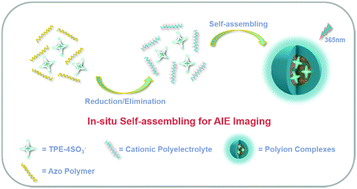Our official English website, www.x-mol.net, welcomes your
feedback! (Note: you will need to create a separate account there.)
In situ construction of a self-assembled AIE probe for tumor hypoxia imaging
Nanoscale ( IF 5.8 ) Pub Date : 2020/03/16 , DOI: 10.1039/d0nr00444h Tianhao Xue 1, 2, 3, 4, 5 , Kuanchun Shao 1, 2, 3, 4, 5 , Jingyuan Xiang 1, 2, 3, 4, 5 , Xinyi Pan 1, 2, 3, 4, 5 , Zixuan Zhu 1, 2, 3, 4, 5 , Yaning He 1, 2, 3, 4, 5
Nanoscale ( IF 5.8 ) Pub Date : 2020/03/16 , DOI: 10.1039/d0nr00444h Tianhao Xue 1, 2, 3, 4, 5 , Kuanchun Shao 1, 2, 3, 4, 5 , Jingyuan Xiang 1, 2, 3, 4, 5 , Xinyi Pan 1, 2, 3, 4, 5 , Zixuan Zhu 1, 2, 3, 4, 5 , Yaning He 1, 2, 3, 4, 5
Affiliation

|
This communication reported a hypoxia-responsive fluorescent probe based on the in situ concept, which combines a water-soluble azobenzene containing copolymer with a carbamate linkage and an anionic water-soluble aggregation-induced emission fluorogen (AIEgen) tetraphenylethene (TPE). The water-soluble copolymer can be transformed into a protonated primary amine containing polymer by the reduction of the azo bond and through a 1,6-self elimination cascade reaction under hypoxic conditions. The transition of anionic TPE from the molecular dispersed state to the aggregation state induced by self-assembly with the cationic polymer would lead to an obvious increase in fluorescence according to the AIE characteristics.
中文翻译:

自组装AIE探针用于肿瘤缺氧成像的原位构建
该通报报道了一种基于原位概念的低氧响应荧光探针,该探针结合了具有氨基甲酸酯键的水溶性含偶氮苯的共聚物和阴离子水溶性聚集诱导的发射氟(AIEgen)四苯基乙烯(TPE)。通过还原偶氮键并通过在缺氧条件下的1,6-自我消除级联反应,可以将水溶性共聚物转化为质子化的含伯胺的聚合物。阴离子TPE从分子分散状态到通过与阳离子聚合物自组装诱导的聚集状态的转变,将根据AIE特性导致荧光的明显增加。
更新日期:2020-04-09
中文翻译:

自组装AIE探针用于肿瘤缺氧成像的原位构建
该通报报道了一种基于原位概念的低氧响应荧光探针,该探针结合了具有氨基甲酸酯键的水溶性含偶氮苯的共聚物和阴离子水溶性聚集诱导的发射氟(AIEgen)四苯基乙烯(TPE)。通过还原偶氮键并通过在缺氧条件下的1,6-自我消除级联反应,可以将水溶性共聚物转化为质子化的含伯胺的聚合物。阴离子TPE从分子分散状态到通过与阳离子聚合物自组装诱导的聚集状态的转变,将根据AIE特性导致荧光的明显增加。











































 京公网安备 11010802027423号
京公网安备 11010802027423号